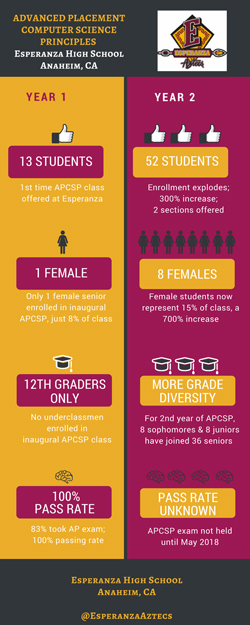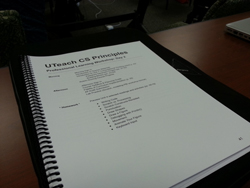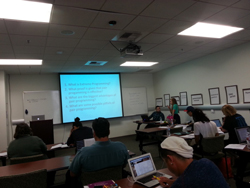My Journey into UTeach AP CSP at Esperanza High School in Anaheim
by Steven Kahn @EsperanzaAztecs | November 28, 2017
As a high school computer science teacher, Steven Kahn shares his inaugural school year [2016-17] teaching AP Computer Science Principles at Esperance High School in Anaheim, CA. During the summer of 2016, to prepare for teaching the course, he took UTeach professional development via a matching grant from Infosys Foundation USA.

My journey into the world of teaching computer science began during the summer of 2016. I had just finished up my single subject teaching credential in mathematics – and was lucky enough to get hired at Esperanza High School to teach both math and computer science. Prior to becoming a teacher, I had earned my Bachelor’s Degree in computer science, worked as a programmer – and performed work in the IT industry for over 10 years. I didn’t necessarily expect to immediately land a job teaching computer science – however it has quickly become apparent that this is a unique calling for me.
Upon being hired at EHS, I was informed that I would be teaching AP Computer Science Principles – in addition to Exploring Computer Science. This would be the very first year that AP CS Principles would be taught nationwide – and the very first year that our school offered any kind of AP Computer Science. Our Assistant Principal (at the time – and now our Principal), Gina Aguilar contacted me to arrange professional development to teach both of these courses. It was decided that I would attend two, week-long/40-hour training sessions over the summer. I was extremely happy to find out that I would be graciously compensated with a $1000 stipend through DonorsChoose.org and Infosys Foundation USA for attending the UTeach AP Computer Science Principles professional development – located at University of California, Irvine. I knew this would be an outstanding opportunity to learn how to teach the course effectively, and to connect with fellow educators.

The training could not have been any better! Our daily sessions were led by curriculum experts: Justin Cannady and Jamie Steck. We were lucky to also have Vinh Luong from University of California, Irvine (UCI) helping with facilities issues, our daily meals, in addition to lingering questions about the DonorsChoose.org process. We had a diverse group of educators gathered from all over the country. Some were locals like myself, and others had traveled from far away just for this training – including Justin and Jamie! One could easily feel the high level of dedication from everybody in the room. Some of us were newer teachers, while others were long time veterans. It was such a pleasure being able to connect and work with such an esteemed and passionate group of people.

Each day, we focused on specific units and activities from the UTeach CSP curriculum. We were able to step into the students’ shoes, and see what it felt like to work through some of the projects ourselves. During this process, Justin & Jamie helped us to become familiar with the "Scratch!" programming environment/language. Coming from a programming background, I was initially somewhat skeptical of what “Scratch!” had to offer. I was concerned that it would seem tedious, and unpractical. However, my initial concerns could not have been further from the truth. Through our experiences using “Scratch!” I realized that not only did “Scratch!” provide an excellent introductory tool for programming – but it also scaled up to allow implementation of more complex, higher level computer science problems/programs. They took us through many other activities and topics covered in the course – and finished off with programming in Processing. I found Processing to be incredibly powerful – especially for beginning coders!
My first year teaching AP CS Principles was a huge success! The professional development has turned out to be incredibly valuable – as has the online educator community. The resources including: the online textbook, daily lesson plans, and planned activities were invaluable. They served as a blueprint – but gave me the flexibility to expand and customize the curriculum as needed. A whopping 83% of my students decided to take the AP test – and of those, 100% of them passed! I believe this was made possible, thanks in part to the high quality curriculum and professional development I received prior to teaching the class.
I run the class with a “project based learning” model. While tests are a part of the course, the majority of students’ grades and learning takes place while completing projects. I try to avoid most “direct teaching” – except in certain instances where it is necessary and/or more beneficial. Whenever possible, I like to create guided activities that allow the students to think critically, and discover new information on their own – or in groups.
I believe the best way to learn this stuff is to “learn by doing.” Team work is another extremely important aspect of my class. Over the course of the year, students have the opportunity to collaborate with virtually every other student in the class – in various group configurations. Projects usually culminate with a presentation – which may be traditional, or in many cases take the form of a “sales pitch.” In these instances, classmates play the role of investors.
Even with more “fact-based” aspects of the course, I often have student groups teach the rest of the class – rather than leading notes/lectures myself. The students find this approach engaging, fun, and interactive. Our 100% pass rate last year is a clear indication that this model is highly effective and engaging for students! I was pleased to hear from many of my students, that they now wanted to major in computer science – whereas they previously had other plans. Many of them remarked how fun, engaging, and practical the class felt. Even those who plan to take other career paths felt that the problem solving and project based skills we learned and embraced would be incredibly valuable in their futures.
For the 2017-18 school year, we experienced and unprecedented rise in enrollment. Coming from one section of 13 students in the previous year, we grew to two sections, and 54 students in total! This is a growth of over 315%! Word apparently travels fast at EHS! This year, our classes are larger, more diverse (in terms of age, gender, ethnic background, etc.), and even more motivated! The future of computer science is looking bright at EHS – so keep your eyes peeled!

